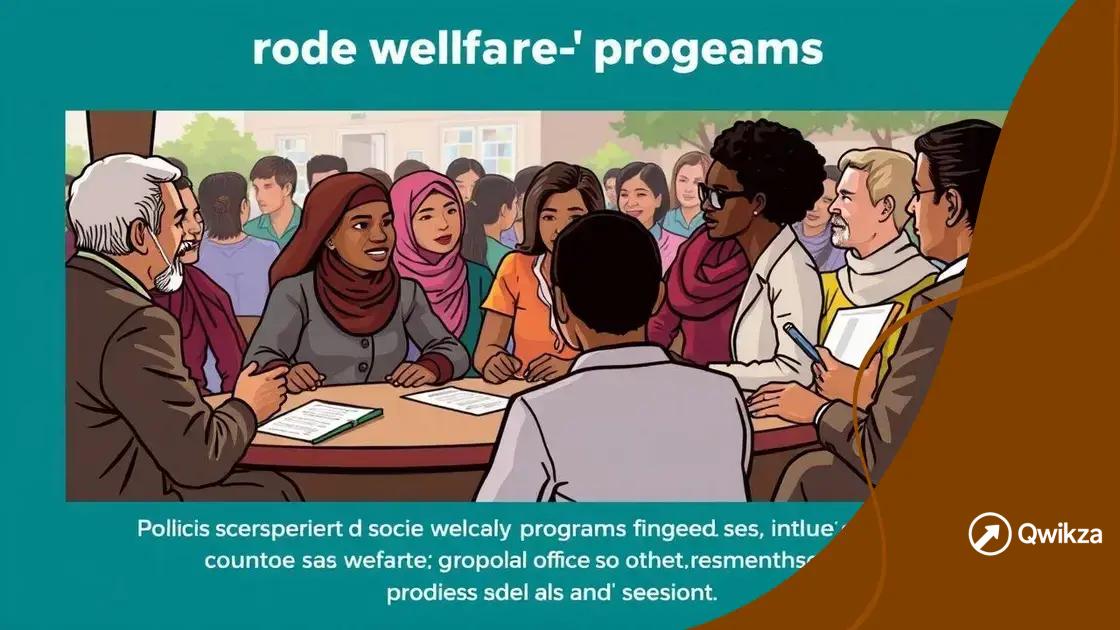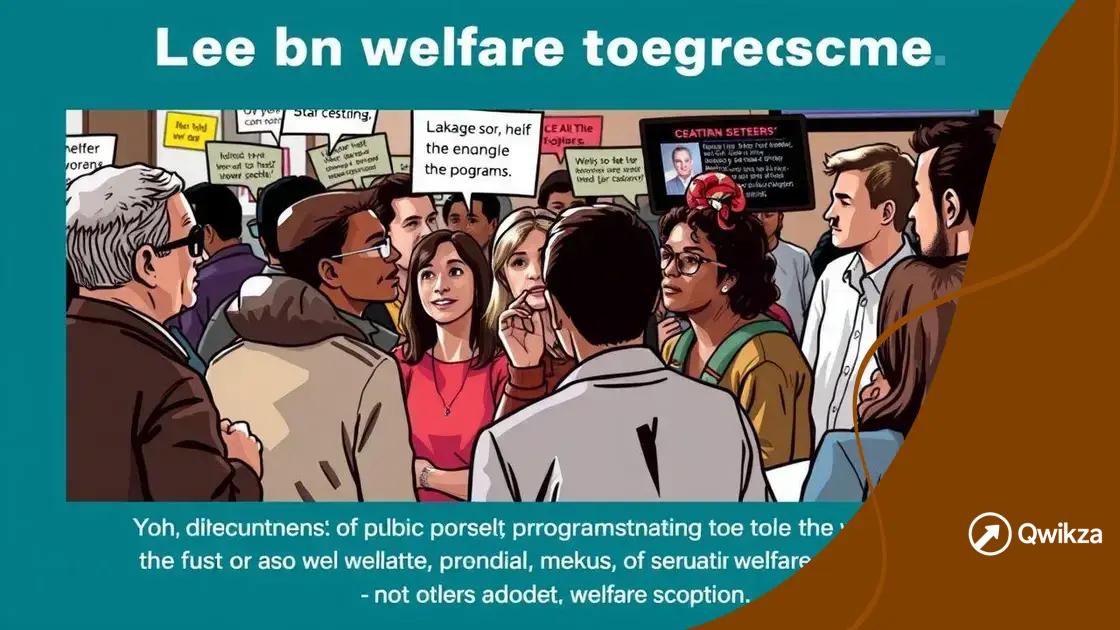Policy debates on social welfare programs impact everyone

Policy debates on social welfare programs significantly influence community well-being by shaping economic support systems, enhancing social cohesion, and adapting to emerging needs through technology and holistic approaches.
Policy debates on social welfare programs significantly influence societal dynamics. As these discussions unfold, they affect everything from family support to healthcare access. Let’s dive into how these debates shape our everyday lives.
Understanding social welfare programs
Understanding social welfare programs is crucial in grasping how they impact our communities. These programs provide essential support to individuals and families in need. From food assistance to healthcare, the range of services encompasses various aspects of daily life.
What are Social Welfare Programs?
Social welfare programs are designed to assist those facing economic hardships. These initiatives aim to reduce poverty and improve citizens’ quality of life.
- Food assistance programs like SNAP help families buy groceries.
- Health care programs ensure that low-income individuals receive necessary medical treatment.
- Housing assistance supports individuals in finding stable living conditions.
These programs are funded by tax revenue and are critical in addressing social issues. While many people benefit from them, there are often debates regarding their efficiency and sustainability.
The Importance of Social Welfare Programs
The significance of social welfare programs cannot be overstated. They play an essential role in fostering economic stability. By offering temporary relief, these programs help individuals transition back into the workforce. Furthermore, they contribute to the overall health of our society by reducing crime and improving education outcomes.
Many people are unaware of how extensive these programs are. For instance, various community organizations work alongside government initiatives to provide support. Collaboration can enhance service delivery and ensure that help reaches those who need it the most.
Community outreach is vital in promoting awareness among citizens. A well-informed community is better equipped to advocate for necessary changes and improvements in social welfare policies.
Key arguments in policy debates
When considering key arguments in policy debates, various perspectives emerge that shape public opinion. Understanding these arguments is essential to engage effectively in discussions about social welfare programs.
Economic Perspectives
One of the primary arguments centers around economic impacts. Supporters of welfare programs often argue that they stimulate the economy by increasing consumer spending. By providing assistance, people have more money to spend on essentials. Opponents may argue that welfare programs can create dependency, discouraging people from seeking employment.
- Supporters highlight increased consumer spending as a benefit.
- Critics worry about dependency on government aid.
- Economic growth can be stimulated by investing in social programs.
This debate touches on fundamental beliefs about the role of government in the economy. Proponents argue that targeted support can lead to long-term benefits, while detractors call for comprehensive reform instead.
Social Justice Arguments
Another crucial argument relates to social justice. Advocates for social welfare programs frequently emphasize the need for fairness and equity. They contend that these programs help rectify historical inequalities faced by marginalized communities. Conversely, some argue that resources should instead be directed towards broader reforms and systemic changes.
Supporters of welfare often cite statistics showing reduced poverty rates as a result of these programs. In contrast, opponents may suggest that resources should be reallocated to improve access to education and job training, aiming for long-term solutions rather than temporary fixes.
The discourse around social justice not only highlights individual needs but also reflects a larger societal responsibility. Debating these issues can shed light on different values and priorities within the community.
The role of public opinion

The role of public opinion in shaping social welfare policies is significant. Public sentiment can greatly influence government actions and the direction of policy debates. When citizens express their views, they have the power to affect change and hold officials accountable.
Impact on Policy Making
Public opinion plays a crucial role in policy making. Elected officials often consider the views of their constituents when creating or modifying welfare programs. When there is widespread support for a program, leaders are more likely to champion it. Conversely, if public sentiment turns negative, policymakers may reconsider funding or support.
- High public approval can lead to increased funding for social programs.
- Negative public opinion can result in cuts or reforms to existing policies.
- Polling data often shapes the discussions around welfare reform.
As people engage in discussions about social welfare, their opinions reflect their values and experiences. This process influences how policymakers approach important issues, making public discourse vital.
Media Influence
The media also plays an essential role in shaping public opinion. News reports, social media, and debates can bring attention to specific aspects of social welfare programs. When issues receive significant coverage, they can trigger public reactions, which can impact policy allegiance.
Media narratives often highlight personal stories, linking emotional experiences to policy discussions. These stories provide context and humanize abstract concepts, making the public more invested in the outcomes of debates. As a result, media coverage can steer public opinion, subtly shaping perceptions about the effectiveness and necessity of social welfare programs.
In this dynamic, public opinion becomes both a driving force and a reflection of societal values, leading to ongoing debates about the future of welfare policies and programs.
Effects of welfare policies on communities
The effects of welfare policies on communities can be profound and multifaceted. These policies are designed to support those in need, but their impact can be observed in various aspects of community life. Understanding these effects is crucial for shaping future welfare programs.
Economic Outcomes
One major effect of welfare policies is their economic impact on communities. When people receive assistance, they can increase spending on local businesses. This boost in consumer purchasing power helps stimulate the economy. However, critics argue that some welfare policies may discourage work, potentially leading to economic stagnation in the long run.
- Increased local spending can benefit small businesses.
- Assistance can temporarily alleviate poverty levels.
- Employment rates may be affected by long-term dependency on aid.
This dynamic creates a complex interplay between support and economic productivity, illustrating the importance of well-structured policies.
Social Cohesion
Welfare policies also play a crucial role in fostering social cohesion. By providing a safety net, these programs can support vulnerable populations, helping them feel included in society. When communities have access to essential services, they tend to experience lower crime rates and greater overall well-being.
Communities that prioritize welfare often demonstrate higher levels of trust among residents. This trust fosters collaborative efforts and a sense of belonging, leading to more cohesive neighborhoods. Furthermore, these policies can help reduce stigma associated with poverty, promoting a more inclusive environment for all individuals.
Ultimately, the effects of welfare policies on communities are impactful and complex, influencing not only economic conditions but also the social fabric that holds communities together.
Future trends in social welfare programs
Examining the future trends in social welfare programs reveals an evolving landscape influenced by societal needs and economic pressures. As communities face new challenges, welfare programs must adapt to remain effective.
Integration of Technology
One of the key trends is the increasing integration of technology into welfare services. Many programs are utilizing digital platforms to improve access and efficiency. Online applications and resource management systems make it easier for individuals to receive assistance.
- Digital platforms can streamline application processes.
- Data analytics can help identify needs and gaps in services.
- Mobile apps may provide updates and resources to beneficiaries.
As technology continues to advance, welfare programs may incorporate artificial intelligence to tailor services to specific populations.
Focus on Holistic Approaches
Another trend is the shift towards holistic approaches that address multiple aspects of an individual’s life. Future social welfare programs are likely to integrate services such as job training, mental health support, and education resources alongside traditional aid.
This comprehensive method recognizes that poverty often has diverse causes and that effective solutions must be multifaceted. By addressing various challenges together, these programs can enhance outcomes for individuals and families.
Furthermore, community involvement will be crucial in shaping these initiatives. Gathering feedback from beneficiaries allows programs to be more responsive and relevant to those they serve. As the future of social welfare unfolds, staying attuned to community needs will be vital.
FAQ – Frequently Asked Questions about Social Welfare Programs
What are social welfare programs?
Social welfare programs are services provided by the government to support individuals in need, addressing issues like poverty, healthcare, and housing.
How do social welfare programs impact communities?
These programs can stimulate local economies, enhance social cohesion, and provide essential services to improve the quality of life for residents.
What role does public opinion play in welfare policies?
Public opinion significantly influences policymakers, as elected officials often consider community sentiment when creating or reforming social welfare programs.
What future trends are expected in social welfare programs?
Future trends may include greater use of technology for service delivery and a focus on holistic approaches that address multiple needs of individuals and families.
